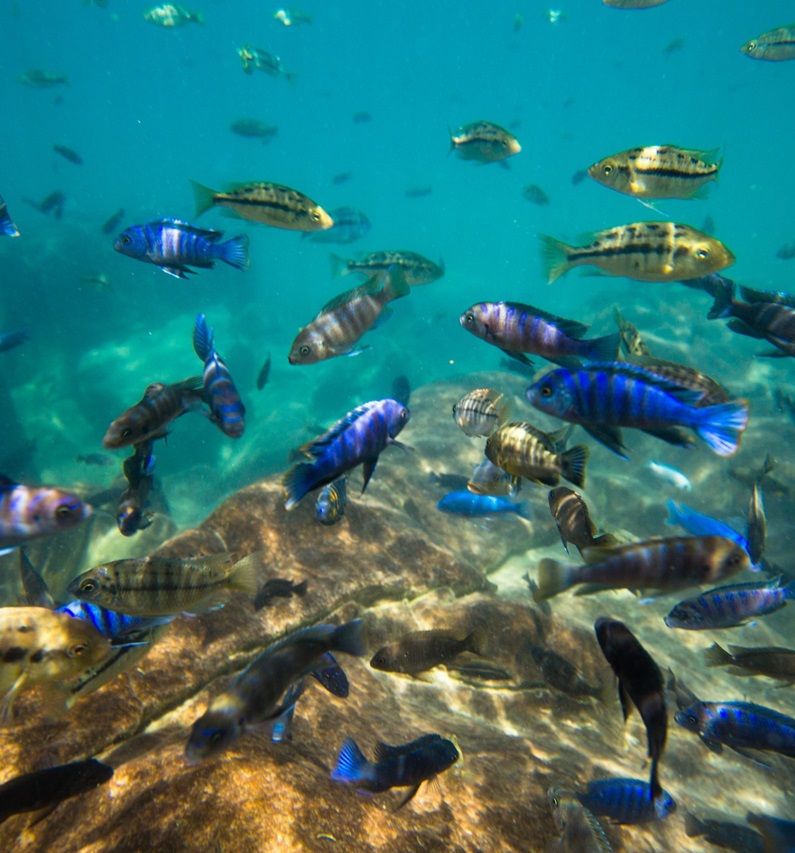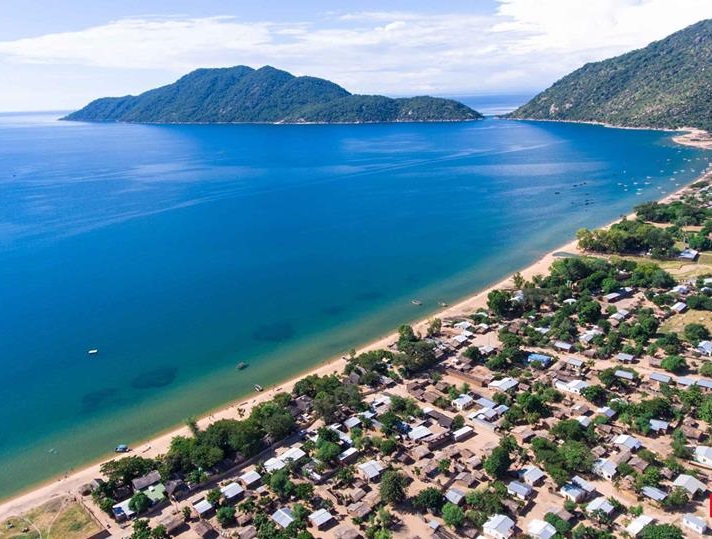Lake Malawi National Park
Nestled in the southern end of the great rift valley, the Lake Malawi National Park stands as a beacon of natural beauty and biodiversity. This UNESCO World Heritage site, established in 1980, offers a unique blend of stunning landscapes and rich aquatic life. The park, which spans over 94 square kilometers (36 sq miles), including both land and water, protects a variety of habitats ranging from rocky shores to wooded hills. The park is a slice of paradise for nature enthusiasts, adventure seekers, and those looking to escape into the tranquility of the African wilderness.
A Sanctuary of Biodiversity
Lake Malawi National Park is renowned for its extraordinary biodiversity. The park, which stretches over an area of about 94 square kilometers, is home to more species of fish than any other lake on Earth, including over 700 species of cichlids. These vibrant fish come in a myriad of shapes, sizes, and colors, and many are endemic to Lake Malawi.
But it’s not just about the fish. The park is also a sanctuary for a variety of wildlife, including baboons, antelopes, and elephants. The lush vegetation provides a habitat for numerous bird species, making it a paradise for bird watchers. With its rich tapestry of flora and fauna, every visit to the park promises a new discovery, offering a glimpse into the heart of Africa’s wild soul.
An Aquatic Wonderland
At the heart of Lake Malawi National Park lies the majestic Lake Malawi, the third-largest lake in Africa and the ninth-largest in the world. Often referred to as the “Calendar Lake,” due to its 365-mile length and 52-mile width, its waters stretch over the eastern border of Malawi, reaching into neighboring Tanzania and Mozambique. What makes Lake Malawi particularly special is its incredible biodiversity. The lake is home to more species of fish than any other lake on Earth, with over 1000 species of cichlids alone, many of which are endemic to its waters.
Diving into the crystal-clear lake, one is surrounded by a kaleidoscope of colorful fish, darting among the intricately shaped rocks and sandy bottoms. Snorkeling and diving are among the most popular activities for visitors, offering an up-close view of the underwater marvels. The park’s commitment to conservation ensures that these aquatic ecosystems continue to thrive, providing a sanctuary for these species and a living laboratory for scientists and ecologists.

Water Activities: More Than Just Sunbathing
A beach holiday in Lake Malawi National Park is incomplete without indulging in the water sports and activities offered. Kayaking, sailing, and even stand-up paddleboarding allow you to glide along the glassy surface of the lake. Dive enthusiasts flock to the park for its world-renowned fresh-water scuba diving experience, exploring the underwater plateaus and the biodiverse aquatic life that awaits beneath the surface.
Additionally, island-hopping boat tours take you to secluded spots like Mumbo and Domwe Islands, which offer their own pristine beaches and nature trails, with rustic accommodations as an option for those seeking an isolated retreat.
Sun, Sand, and Serenity: The Basics of a Lake Malawi Beach Holiday
Lake Malawi National Park comprises the southernmost tip of the lake, encapsulating a cluster of the lake’s over 500 islands. Its shores are trimmed with golden sandy beaches that rival those of any tropical seafront. The park’s gateway town, Cape Maclear, is a prime location to begin your beach holiday. Here, you can find an array of accommodation options from eco-lodges to luxury resorts that cater to various preferences and budgets while emphasizing the conservation ethos of their surroundings.
Your usual beach day at Lake Malawi would start with a soothing sunrise, gentle waves lapping against the sand, and the distant calls of fish eagles — iconic to this region. As the sun climbs, dip into the silk-like waters for a swim or snorkel and be fascinated by the vividly colored cichlid fish that animate the clear shallow waters.
CAPE MACLEAR BEACHES

A Foray into the Wild
Beyond the aquatic allure, Lake Malawi National Park is endowed with a lush landscape that beckons to be explored. The park’s topography is marked by rugged hills, wooded areas, and isolated islands, each providing a distinct ecological niche. Trekking through the park, one encounters a variety of plant species, from baobab trees to orchids, giving way to stunning vistas of the lake and providing habitat for diverse wildlife.
Though the park is more renowned for its aquatic diversity, it is also home to a number of land animals. While you may not find the big five that Africa is famous for, you can expect to see baboons, antelope, and a rich array of bird species. Eagle-eyed birdwatchers can spot African fish eagles, hornbills, and cormorants, among others, adding to the park’s rich tapestry of life.
A Cultural Hotspot
The Lake Malawi National Park is not only a natural sanctuary but also a cultural one. The local communities surrounding the park have deep ties to the land and the lake, with traditions and ways of living that have remained largely unchanged for centuries. The park offers a chance for visitors to engage with local communities and learn about their way of life, which is closely intertwined with the rhythms of nature.
Traditional fishing methods are still practiced here, and visitors can observe fishermen casting their nets in the early morning light, a practice passed down through generations. Village walks and cultural experiences provide a glimpse into the everyday lives of the local people, offering lessons in simplicity and sustainability.
Marvel at the Sunset
No visit to Lake Malawi National Park is complete without witnessing its breathtaking sunsets. As the sun dips below the horizon, the sky is set ablaze in hues of orange, pink, and purple, reflecting on the lake’s tranquil surface. It’s a daily spectacle that captures the essence of Africa’s raw beauty—tranquil yet vibrant, timeless yet ever-changing.
Practical Tips for Visiting Lake Malawi National Park
- Getting There: The park is accessible by road from Malawi’s major cities, and the nearest airport is in Monkey Bay. Boat services are also available from various points along the lakeshore.
- Accommodations: Options range from budget-friendly campgrounds to luxury eco-lodges. Many lodges offer guided tours and activities within the park.
- Best Time to Visit: Malawi has a warm tropical climate; the best time to visit is in the dry season, from May to October, when wildlife is easier to spot, and the weather is more pleasant for outdoor activities.
- Health and Safety: Ensure you have the necessary vaccinations and anti-malarial medication. It’s also advisable to have comprehensive travel insurance.
